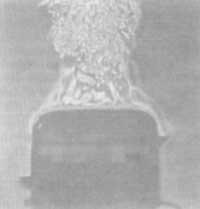Sauna; thermodynamics of a small hell
1995/03/01 Arrasate Aierbe, Javier Iturria: Elhuyar aldizkaria
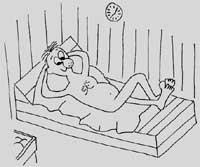
Wedding day is not for jokes. It is eaten, drunk and danced from noon to evening at night, without being satiated. A body without custom does not easily support this type of play. Seeing Xabier was enough to agree. The poor had there, lying in bed, without getting up, to face the pain of the next day as best as possible. Leaving his neighbor asleep, he rose with a skull, and leaving aside those wonderful jackets and pants wrinkles that he had thrown all night on the ground, put the tracksuit on top, formed a sports bag and remembered what his best friend Joxe Miel recommended. “Have you ever been in the sauna? It should go. Sweating removes dirt and is perfect for relaxing,” he said. “Come on. Come on,” Xabier thought, which was the right time.
He undressed in the changing rooms of the sports center, the Chinese were placed and with the towel on his neck he went to the wooden door with box office, with the slogan “now or never!”. He said “Good morning!” to the fat poor man lying on the gut, sweating the wrinkles of the belly skin on the pats. There were three levels to sit on. He climbed to the top and placed the towel stretched into the seat. His first thought was “Wow!” And this small room, with wooden walls, ceiling and floor, was in the boiler, and when she realized that she was also soaked with sweat. As his head approached the meter above the wall, he read 80°C. How can man withstand such intense heat? “Download to the bottom because it’s too hot there,” the fat man said. Next to the thermometer was another meter called a 35% hygrometer. What measurement was that?
With these ideas, as he went down to the bottom, he realized that the lazy finger of the right hand was burning. The gold ring I had just put on the eve was ready! While the ring was being removed, the old man asked Xabier if he cared to throw some water at the stones below. Reply no, to throw whatever you want. The man took water with a wooden tower and poured it into the stone. The water, as it touched the stones, became perfume and came to the face in a calcinous streaks. That hell was untenable! It was ten minutes past and instead of drowning he opened the door and left, fleeing from hell in search of heaven...
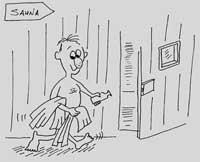
Until now, the anecdote that has passed to Xabier, can happen to anyone, and they are undoubtedly events that everyone who has scientific curiosity has reflected several times when passing through the sauna. The aim of this work is to provide a scientific response to the events that occurred in the past, and for this we have to talk about two main themes: the nature of air and the transmission of heat. We start with the first one without extending more in the entries.
Air, in addition to being a mixture of several gases, has the ability to store water in a state of steam. The air in our atmosphere has water. This is why it is called wet air. In what proportion air and in what proportion water? Well, as clarification, in the normal pressure of the atmosphere and at 25ºC each kilogram of dry air has a storage capacity of approximately 20 grams of water. Water can be added to a smaller air under these conditions and absorbed. However, if we give a drop of different water to the air that is storing this large amount, the air will not collect it and as a liquid it will remain on any surface of its environment.
This amount of water in the air, with constant pressure, depends on the temperature: the higher temperature, the greater the amount possible. It is evident the need for a measure that relates the amount of water in the air and that it can contain on an equal basis. It exists and is that gives us the hygrometer that Xabier saw. The 35% reading is as follows: At 80°C, if a kilogram of dry air can contain 544 grams of water, the sauna air per hour had 35% of that amount, that is, 190 grams.
There are a number of facts that can appear in nature through the above, such as the case of dew. Suppose the humidity of the air at 25ºC during the day, measured by a hygrometer, is 50%. Consequently, in every dry air there are 10 grams of water. At night the temperature has dropped much to 0º C and everything that can be at this new temperature is only 4 grams. What happens to another 6 grams? It appears as liquid in the grass, in cars...

The second issue was heat transmission. Come on. Let's first explain what heat is. If two bodies are put in contact at different temperatures, the energy will pass from the highest body to the other, to match the temperatures of both. This latter situation is balanced and hot, that is, past energy. However, this heat transmission can occur in three ways. Let's analyze them one by one.
The first is driving. The bodies are formed by minor fractions. These have vibratory movement and the faster the movement, the higher the temperature we know. When we put it in contact with the body at a lower temperature, this movement is transmitted to the particles of the other body. As a clarification, when you are holding with your hand the end of an iron mast and calents the other end in the fire, soon you will be able to feel that heat in your hand.
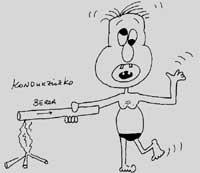
Remember also the case of Javier's ring. His finger was not at a temperature above 36°C. However, the ring seemed to be at higher temperature and so it burned the finger. Heat transmission between solids is thus produced. However, in solids faster than in others. Imagine two apparently equal houses (walls of equal thickness, equal in size, equal temperature difference between the exterior and the interior...) but in one case with wooden walls and in the other with metal. Which one cools faster? Experience shows us that metal cools faster, as metals are good heat conductors.
However, and as has been said at the beginning, it is not the only way to do so. In the middle of winter, when we light the heating in the houses, they heat the air they have next to them by driving. The density of this air decreases and, as Archimedes explained earlier, it rises. In its movement the lower heat has increased. In driving there was no average movement of mass. Here yes. This second form is called convection and we can see it in the milk we heat each morning. This type of transmission always appears if there is gas or liquid involved in the transmission medium. The nature of the fluid, around the solid that warms or cools its movement, the geometry of this solid and many other factors have importance in the speed of heat transmission.
Let's look at the following analogy that helps us clarify concepts for driving and convection cases.
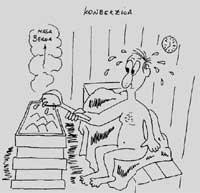
As long as there is a height difference between the water levels of both vessels, water will flow from one to the other, as if the temperature difference was maintained, a heat leak would occur. How long? To match heights/temperatures. What depends on it being faster or slower? Depending on the characteristics of the intermediate duct: narrow or wide section, rough or completely smooth surface, etc. The tube has a hydraulic resistance that depends on these characteristics. We talk about thermal resistance, and the material or environment that makes it difficult to heat flow, for us will be of great thermal resistance. When talking about driving we mentioned two houses.
In one case the walls were made of wood, in the other of metal. The former have higher thermal resistance, so they will better retain the interior heat.
Undoubtedly, in our sauna, and being the fluid the humid air, convection is the main of the two previous forms. Remember, if not, the moment when man throws a skewer at the stones. The water, just touching the stones that were hundreds of degrees, became steam and headed to the convective currents at a strong speed.
However, there is a third way: radiation.
Ask yourselves that, being almost empty the space between the sun and the earth, how does the energy emitted by the sun reach the ground? If the sun warms the earth (being impossible driving and convection; there is no mass), how is that energy transported here? This is the last way.
The surface of any body emits energy appropriate to its temperature by electromagnetic waves capable of crossing the empty space. The amount of energy depends on the characteristics of the surface. This energy is divided into different wavelengths, most of which are in a wavelength interval.

The human being, being at 36ºC, emits energy, most of it in infrared waves. Therefore, helped by special binoculars, any person or animal would be in a lower temperature environment. Haven’t you seen Arnold Schwartzenegger’s “Predator”? In it an enveloping beast of another planet sees it in the infrared spectrum. Aware of this, our giant Arnold has rubbed the whole body with a colder mud, which has allowed him to escape.
Exposed all the above, we are equipped with the necessary theories to make some reflections and, simply, to respond to those questioned in the sauna.
How is it heated? Through these stony ones. These have an important goal: store a lot of heat and release it slowly. Why? Due to its high thermal resistance, heat release is progressive. On the other hand, in order for its temperature to rise to a degree it must be very hot. Therefore, they retain a great heat for their temperature.
In several homes, and taking advantage of the cheapest night electric toll, the so-called heat accumulators heat refractory bricks (resistant to high temperatures without cracking). Its characteristics are similar to those of the stones of Sauna, which allows to heat the house during the day. That is, consume at night and warm up day.
The main ways to heat the room are convection and radiation. The radiant energy does not remain directly in the air, since the latter can be considered transparent to electromagnetic waves. It is absorbed by the walls. On the other hand, the air in contact with the stones is in continuous movement in the convection currents, keeping the room temperature quite homogeneous. However, as the hottest air is lighter, it accumulates at the top and therefore, sitting up, Javier felt more heat.

Why did the feeling of heat increase when he poured water into the stones? At higher relative air humidity, lower thermal resistance between body and air. Therefore, the flow of heat into the body will increase and we, if we want to keep it at the same temperature, will have to release more heat. Our mechanism is sweat.
This explanation answers other more everyday questions. Have you never heard that the cold here, for example 5 ° C here, is colder than 5 ° C of Madrid? Having more moisture from here, the heat is easier!
In thermodynamic equilibrium, all interior objects are at the same temperature. That is, the towel and ring are 80ºC. Why does the ring burn and towel not? The ring is in direct contact with the finger. Driving is the only way to pass heat between the two. Its thermal resistance is low and touching it comes in a lot of heat. There is the feeling of heat. However, the towel is very bad conductive, of great resistance, and despite the same temperature difference, it has great obstacles for the heat to enter us. The towel feels hot but does not smoke.
Why are the walls made of wood and not of metal? The same answer as the previous one. Our Javier came out at full speed and made no reflection on it. After a few days, with the body more prepared, he returned, and at that moment he began to break his head. In the village library he opened a book full of powders entitled “Thermodynamics” and began to learn... So far.

Gai honi buruzko eduki gehiago
Elhuyarrek garatutako teknologia




